Frymaster OCF30 User Manual
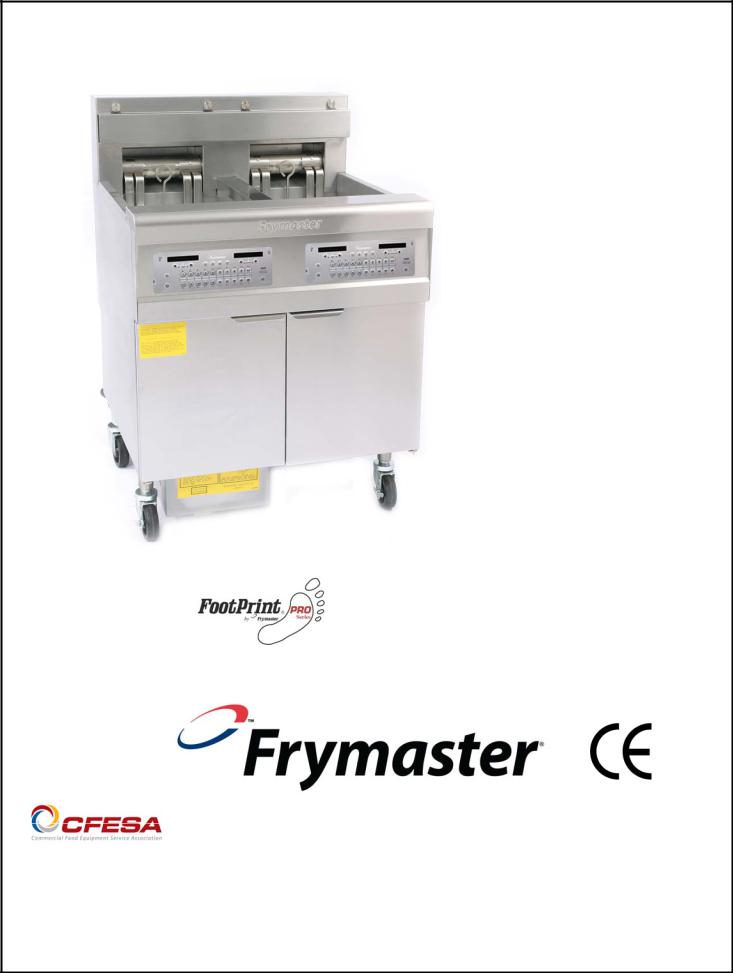
Manual Operation & Installation |
(OCF30) Fryer Conserving Oil Fryers Series Electric |
|
™ |
|
|
Frymaster, a member of the Commercial Food Equipment Service Association, recommends using CFESA Certified Technicians.
|
24-Hour Service Hotline 1-800-551-8633 |
JUNE 2011 |
|
|
|
|
|
www.frymaster.com |
E-mail: service@frymaster.com |
*8196685* |
|
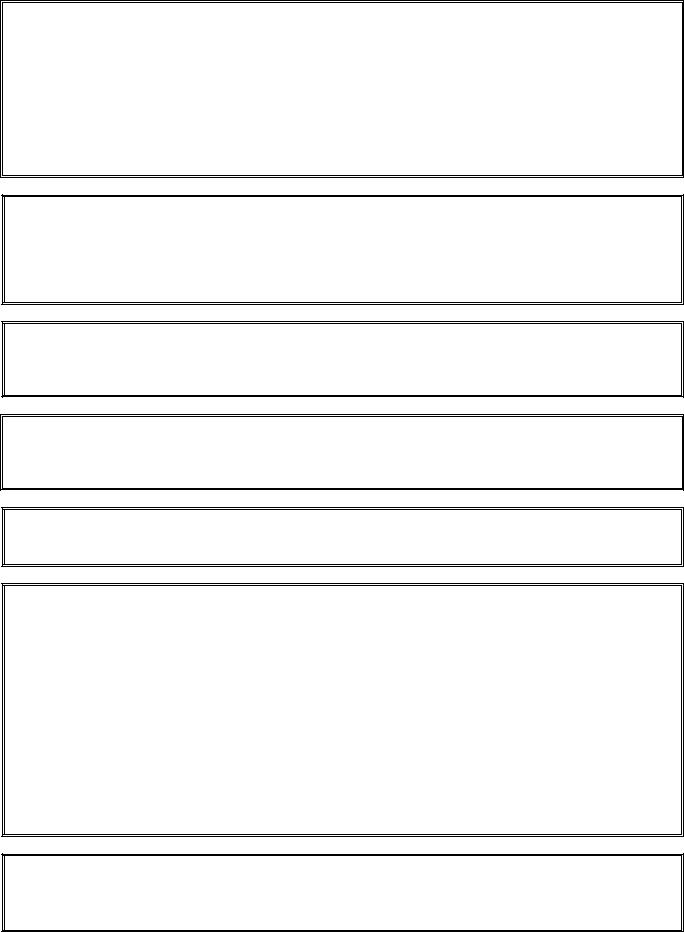
NOTICE
IF, DURING THE WARRANTY PERIOD, THE CUSTOMER USES A PART FOR THIS MANITOWOC FOOD SERVICE EQUIPMENT OTHER THAN AN UNMODIFIED NEW OR RECYCLED PART PURCHASED DIRECTLY FROM FRYMASTER DEAN, OR ANY OF ITS AUTHORIZED SERVICE CENTERS, AND/OR THE PART BEING USED IS MODIFIED FROM ITS ORIGINAL CONFIGURATION, THIS WARRANTY WILL BE VOID. FURTHER, FRYMASTER DEAN AND ITS AFFILIATES WILL NOT BE LIABLE FOR ANY CLAIMS, DAMAGES OR EXPENSES INCURRED BY THE CUSTOMER WHICH ARISE DIRECTLY OR INDIRECTLY, IN WHOLE OR IN PART, DUE TO THE INSTALLATION OF ANY MODIFIED PART AND/OR PART RECEIVED FROM AN UNAUTHORIZED SERVICE CENTER.
NOTICE
This appliance is intended for professional use only and is to be operated by qualified personnel only. A Frymaster Dean Factory Authorized Servicer (FAS) or other qualified professional should perform installation, maintenance, and repairs. Installation, maintenance, or repairs by unqualified personnel may void the manufacturer’s warranty. See Chapter 1 of this manual for definitions of qualified personnel.
NOTICE
This equipment must be installed in accordance with the appropriate national and local codes of the country and/or region in which the appliance is installed. See NATIONAL CODE REQUIREMENTS in Chapter 2 of this manual for specifics.
NOTICE TO U.S. CUSTOMERS
This equipment is to be installed in compliance with the basic plumbing code of the Building Officials and Code Administrators International, Inc. (BOCA) and the Food Service Sanitation Manual of the U.S. Food and Drug Administration.
NOTICE
Drawings and photos used in this manual are intended to illustrate operational, cleaning and technical procedures and may not conform to onsite management operational procedures.
NOTICE TO OWNERS OF UNITS EQUIPPED WITH CONTROLLERS
U.S.
This device complies with Part 15 of the FCC rules. Operation is subject to the following two conditions: 1) This device may not cause harmful interference, and 2) This device must accept any interference received, including interference that may cause undesired operation. While this device is a verified Class A device, it has been shown to meet the Class B limits.
CANADA
This digital apparatus does not exceed the Class A or B limits for radio noise emissions as set out by the ICES-003 standard of the Canadian Department of Communications.
Cet appareil numerique n’emet pas de bruits radioelectriques depassany les limites de classe A et B prescrites dans la norme NMB-003 edictee par le Ministre des Communcations du Canada.
 DANGER
DANGER
Improper installation, adjustment, maintenance or service, and unauthorized alterations or modifications can cause property damage, injury, or death. Read the installation, operating, and service instructions thoroughly before installing or servicing this equipment.
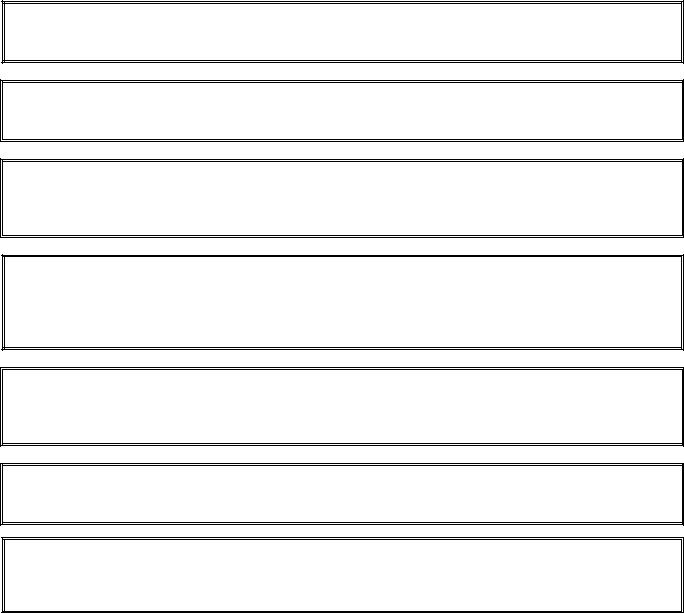
 DANGER
DANGER
The front ledge of this appliance is not a step! Do not stand on the appliance. Serious injury can result from slips or contact with the hot cooking oil.
 DANGER
DANGER
Do not store or use gasoline or other flammable liquids or vapors in the vicinity of this or any other appliance.
 DANGER
DANGER
The crumb tray in fryers equipped with a filter system must be emptied into a fireproof container at the end of frying operations each day. Some food particles can spontaneously combust if left soaking in certain shortening material.
 WARNING
WARNING
Do not bang fry baskets or other utensils on the fryer’s joiner strip. The strip is present to seal the joint between the fry vessels. Banging fry baskets on the strip to dislodge shortening will distort the strip, adversely affecting its fit. It is designed for a tight fit and should only be removed for cleaning.
 DANGER
DANGER
Adequate means must be provided to limit the movement of this appliance without depending on or transmitting stress to the electrical conduit. A restraint kit is provided with the fryer. If the restraint kit is missing contact your local KES.
 DANGER
DANGER
Prior to movement, testing, maintenance and any repair on your Frymaster fryer, disconnect ALL electrical power from the fryer.
NOTICE
The instructions in this manual for using a bulk oil system for filling and discarding oil are for an RTI and Frontline system. These instructions may not be applicable to other bulk oil systems.

OCF30™ Series Electric Fryers
Installation and Operation Manual
TABLE OF CONTENTS
CHAPTER 1: Introduction |
|
||
1.1 |
General..................................................................................................................................... |
1-1 |
|
1.2 |
Safety Information ................................................................................................................... |
1-1 |
|
1.3 |
Computer Information.............................................................................................................. |
1-2 |
|
1.4 |
European Community (CE) Specific Information ................................................................... |
1-2 |
|
1.5 |
Installation, Operating, and Service Personnel ........................................................................ |
1-2 |
|
1.6 |
Definitions................................................................................................................................ |
1-2 |
|
1.7 |
Shipping Damage Claim Procedure......................................................................................... |
1-3 |
|
1.8 |
Service Information.................................................................................................................. |
1-3 |
|
CHAPTER 2: Installation Instructions |
|
||
2.1 |
General Installation Requirements........................................................................................... |
2-1 |
|
|
2.1.1 |
Clearance and Ventilation............................................................................................ |
2-2 |
|
2.1.2 |
Electrical Grounding Requirements............................................................................. |
2-2 |
|
2.1.3 |
Australian Requirements.............................................................................................. |
2-3 |
2.2 |
Power Requirements ................................................................................................................ |
2-3 |
|
2.3 |
Positioning the Fryer................................................................................................................ |
2-4 |
|
CHAPTER 3: Operating Instructions |
|
||
3.1 |
Equipment Setup and Start-Up Procedures.............................................................................. |
3-2 |
|
3.2 |
Operation.................................................................................................................................. |
3-2 |
|
3.3 |
Oil Attendant™ Automatic Topoff.......................................................................................... |
3-3 |
|
|
3.3.1 Prepare the System for Use.......................................................................................... |
3-3 |
|
|
3.3.2 Install the Oil Reservoir ............................................................................................... |
3-3 |
|
|
3.3.3 |
Routine Oil Changes .................................................................................................... |
3-3 |
|
3.3.4 |
Bulk Oil Systems ......................................................................................................... |
3-4 |
CHAPTER 4: Filtration Instructions |
|
||
4.1 |
Preparing the Built-In Filtration System for Use ..................................................................... |
4-1 |
|
|
4.1.1 Preparation for Use with Filter Paper or Filter Pad....................................................... |
4-1 |
|
|
4.1.2 Preparation for Use with Magnasol Filter Assembly.................................................... |
4-2 |
|
4.2 |
Filtration................................................................................................................................... |
4-3 |
|
|
4.2.1 Operation of the Filter................................................................................................... |
4-3 |
|
4.3 |
Disassembly and Reassembly of the Magnasol Filter .............................................................. |
4-5 |
|
4.4 |
Draining and Disposing of Waster Oil...................................................................................... |
4-6 |
|
CHAPTER 5: Preventive Maintenance |
|
||
5.1 |
Cleaning the Fryer.................................................................................................................... |
5-1 |
|
5.2 |
Daily Checks and Service ........................................................................................................ |
5-1 |
|
|
5.2.1 Inspect Fryer for Damage ............................................................................................. |
5-1 |
|
|
5.2.2 Clean Fryer Cabinet Inside and Out.............................................................................. |
5-1 |
|
|
5.2.3 Clean the Built-in Filtration System ............................................................................. |
5-1 |
|
5.3 |
Weekly Checks and Service..................................................................................................... |
5-2 |
|
|
5.3.1 Clean Frypot and Heating Elements ............................................................................. |
5-2 |
|
|
5.3.2 Boiling Out the Frypot .................................................................................................. |
5-2 |
|
|
5.3.3 Clean Detachable Parts and Accessories....................................................................... |
5-3 |
|
iv

OCF30™ Series Electric Fryers
Installation and Operation Manual
TABLE OF CONTENTS
CHAPTER 1: Introduction |
|
||
1.1 |
General..................................................................................................................................... |
1-1 |
|
1.2 |
Safety Information ................................................................................................................... |
1-1 |
|
1.3 |
Computer Information.............................................................................................................. |
1-2 |
|
1.4 |
European Community (CE) Specific Information ................................................................... |
1-2 |
|
1.5 |
Installation, Operating, and Service Personnel ........................................................................ |
1-2 |
|
1.6 |
Definitions................................................................................................................................ |
1-2 |
|
1.7 |
Shipping Damage Claim Procedure......................................................................................... |
1-3 |
|
1.8 |
Service Information.................................................................................................................. |
1-3 |
|
CHAPTER 2: Installation Instructions |
|
||
2.1 |
General Installation Requirements........................................................................................... |
2-1 |
|
|
2.1.1 |
Clearance and Ventilation............................................................................................ |
2-2 |
|
2.1.2 |
Electrical Grounding Requirements............................................................................. |
2-2 |
|
2.1.3 |
Australian Requirements.............................................................................................. |
2-3 |
2.2 |
Power Requirements ................................................................................................................ |
2-3 |
|
2.3 |
Positioning the Fryer................................................................................................................ |
2-4 |
|
CHAPTER 3: Operating Instructions |
|
||
3.1 |
Equipment Setup and Start-Up Procedures.............................................................................. |
3-2 |
|
3.2 |
Operation.................................................................................................................................. |
3-2 |
|
3.3 |
Oil Attendant™ Automatic Topoff.......................................................................................... |
3-3 |
|
|
3.3.1 Prepare the System for Use.......................................................................................... |
3-3 |
|
|
3.3.2 Install the Oil Reservoir ............................................................................................... |
3-3 |
|
|
3.3.3 |
Routine Oil Changes .................................................................................................... |
3-3 |
|
3.3.4 |
Bulk Oil Systems ......................................................................................................... |
3-4 |
CHAPTER 4: Filtration Instructions |
|
||
4.1 |
Preparing the Built-In Filtration System for Use ..................................................................... |
4-1 |
|
|
4.1.1 Preparation for Use with Filter Paper or Filter Pad....................................................... |
4-1 |
|
|
4.1.2 Preparation for Use with Magnasol Filter Assembly.................................................... |
4-2 |
|
4.2 |
Filtration................................................................................................................................... |
4-3 |
|
|
4.2.1 Operation of the Filter................................................................................................... |
4-3 |
|
4.3 |
Disassembly and Reassembly of the Magnasol Filter .............................................................. |
4-5 |
|
4.4 |
Draining and Disposing of Waster Oil...................................................................................... |
4-6 |
|
CHAPTER 5: Preventive Maintenance |
|
||
5.1 |
Cleaning the Fryer.................................................................................................................... |
5-1 |
|
5.2 |
Daily Checks and Service ........................................................................................................ |
5-1 |
|
|
5.2.1 Inspect Fryer for Damage ............................................................................................. |
5-1 |
|
|
5.2.2 Clean Fryer Cabinet Inside and Out.............................................................................. |
5-1 |
|
|
5.2.3 Clean the Built-in Filtration System ............................................................................. |
5-1 |
|
5.3 |
Weekly Checks and Service..................................................................................................... |
5-2 |
|
|
5.3.1 Clean Frypot and Heating Elements ............................................................................. |
5-2 |
|
|
5.3.2 Boiling Out the Frypot .................................................................................................. |
5-2 |
|
|
5.3.3 Clean Detachable Parts and Accessories....................................................................... |
5-3 |
|
iv
5.4 |
Monthly Checks and Service ................................................................................................... |
5-3 |
|
|
5.4.1 Check Controller Setpoint Accuracy ............................................................................ |
5-3 |
|
5.5 |
Annual/Periodic System Inspection......................................................................................... |
5-3 |
|
|
5.5.1 |
Fryer.............................................................................................................................. |
5-3 |
|
5.5.2 |
Built-In Filtration System ............................................................................................. |
5-4 |
CHAPTER 6: Operator Troubleshooting |
|
||
6.1 |
Introduction.............................................................................................................................. |
6-1 |
|
6.2 |
Troubleshooting....................................................................................................................... |
6-2 |
|
|
6.2.1 Controller and Heating Problems ................................................................................. |
6-2 |
|
|
6.2.2 Error Message and Display Problems........................................................................... |
6-2 |
|
|
6.2.3 |
Basket Lift Problems .................................................................................................... |
6-3 |
|
6.2.4 |
Filtration Problems ....................................................................................................... |
6-4 |
|
6.2.5 Auto Top Off Problems ................................................................................................ |
6-4 |
|
|
6.2.6 |
Error Log Codes............................................................................................................ |
6-5 |
|
6.2.7 |
High Limit Test............................................................................................................. |
6-5 |
CHAPTER 7: Wiring Diagrams |
|
||
7.1 |
Simplified OCF30 Wiring ....................................................................................................... |
7-1 |
|
7.2 |
Component Wiring Domestic with 3000 controller ................................................................ |
7-2 |
|
7.3 |
Component Wiring Domestic with CM3.5 controller ............................................................. |
7-3 |
|
7.4 |
Component Wiring CE ............................................................................................................ |
7-4 |
|
7.5 |
Component Wiring CSA.......................................................................................................... |
7-5 |
|
7.6 |
Contactor Box-Delta Configuration......................................................................................... |
7-6 |
|
7.7 |
Contactor Box-WYE Configuration ........................................................................................ |
7-7 |
|
ADDENDUM A: Solid Shortening JIB Preparation Instructions
ADDENDUM B: Solid Shortening Melter Use Instructions
ADDENDUM C: Bulk Oil Instructions
v

1.3Computer Information
This equipment has been tested and found to comply with the limits for a Class A digital device, pursuant to Part 15 of the FCC rules. While this device is a verified Class A device, it has been shown to meet the Class B limits. These limits are designed to provide reasonable protection against harmful interference when the equipment is operated in a commercial environment. This equipment generates, uses and can radiate radio frequency energy and, if not installed and used in accordance with the instruction manual, may cause harmful interference to radio communications. Operation of the equipment in a residential area is likely to cause harmful interference in which case the user will be required to correct the interference at their own expense.
The user is cautioned that any changes or modifications not expressly approved by the party responsible for compliance could void the user's authority to operate the equipment.
If necessary, the user should consult the dealer or an experienced radio and television technician for additional suggestions.
The user may find the following booklet prepared by the Federal Communications Commission helpful: "How to Identify and Resolve Radio-TV Interference Problems". This booklet is available from the U.S. Government Printing Office, Washington, DC 20402, Stock No. 004-000-00345-4.
1.4European Community (CE) Specific Information
The European Community (CE) has established certain specific standards regarding equipment of this type. Whenever a difference exists between CE and non-CE standards, the information or instructions concerned are identified by means of shadowed boxes similar to the one below.
CE Standard
Example of box used to distinguish CE and
Non-CE specific information.
1.5Installation, Operating, and Service Personnel
Operating information for Frymaster equipment has been prepared for use by qualified and/or authorized personnel only, as defined in Section 1.6. All installation and service on Frymaster equipment must be performed by qualified, certified, licensed, and/or authorized installation or service personnel, as defined in Section 1.6.
1.6Definitions
QUALIFIED AND/OR AUTHORIZED OPERATING PERSONNEL
Qualified/authorized operating personnel are those who have carefully read the information in this manual and have familiarized themselves with the equipment functions, or who have had previous experience with the operation of the equipment covered in this manual.
1-2
QUALIFIED INSTALLATION PERSONNEL
Qualified installation personnel are individuals, firms, corporations, and/or companies which, either in person or through a representative, are engaged in and are responsible for the installation of electrical appliances. Qualified personnel must be experienced in such work, be familiar with all electrical precautions involved, and have complied with all requirements of applicable national and local codes.
QUALIFIED SERVICE PERSONNEL
Qualified service personnel are those who are familiar with Frymaster equipment and who have been authorized by Frymaster, L.L.C. to perform service on the equipment. All authorized service personnel are required to be equipped with a complete set of service and parts manuals, and to stock a minimum amount of parts for Frymaster equipment. A list of Frymaster Factory Authorized Servicers (FAS’s) is located on the Frymaster website at www.frymaster.com. Failure to use qualified service personnel will void the Frymaster warranty on your equipment.
1.7Shipping Damage Claim Procedure
What to do if your equipment arrives damaged:
Please note that this equipment was carefully inspected and packed by skilled personnel before leaving the factory. Frymaster does not assume responsibility for damage or loss incurred in transit. The freight company assumes full responsibility for safe delivery upon acceptance of the equipment.
1.File Claim for Damages Immediately—Regardless of extent of damage.
2.Visible Loss or Damage—Be sure this is noted on the freight bill or express receipt and is signed by the person making the delivery.
3.Concealed Loss or Damage—If damage is unnoticed until equipment is unpacked, notify the freight company or carrier immediately and file a concealed damage claim. This should be done within 15 days of date of delivery. Be sure to retain container for inspection.
1.8Service Information
For non-routine maintenance or repairs, or for service information, contact your local Frymaster Factory Authorized Servicer (FAS). Service information may also be obtained by calling the Frymaster Technical Services Department at 1-800-551-8633 or 1-318-865-1711 or by e-mail at service@frymaster.com. The following information will be needed in order to assist you efficiently:
Model Number_________________________
Serial Number _________________________
Voltage ______________________________
Nature of the Problem ___________________
____________________________________
____________________________________
RETAIN AND STORE THIS MANUAL IN A SAFE PLACE FOR FUTURE USE.
1-3
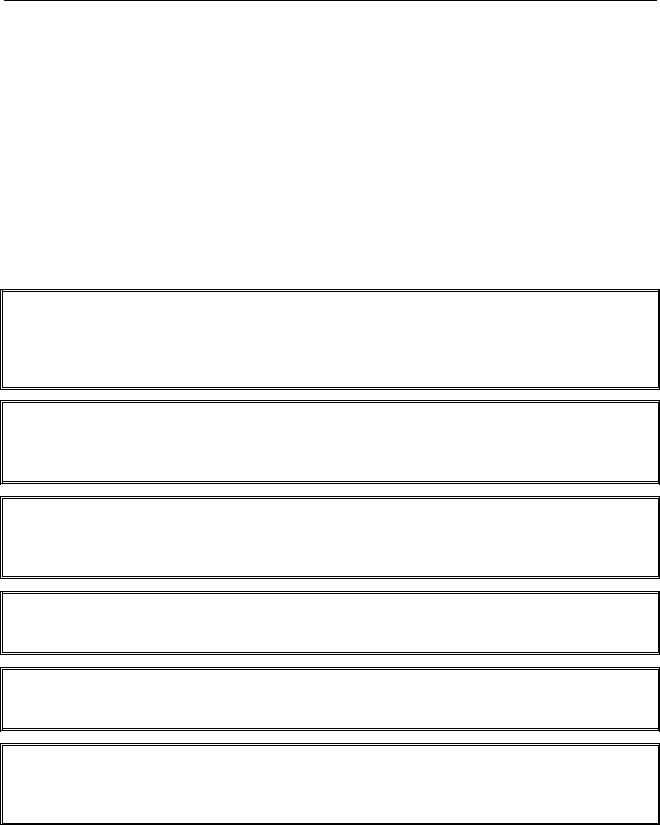
OCF30™ II SERIES ELECTRIC FRYERS
CHAPTER 2: INSTALLATION INSTRUCTIONS
2.1General Installation Requirements
Proper installation is essential for the safe, efficient, trouble-free operation of this appliance.
Qualified, licensed, and/or authorized installation or service personnel, as defined in Section 1.6 of this manual, should perform all installation and service on Frymaster equipment.
Failure to use qualified, licensed, and/or authorized installation or service personnel (as defined in Section 1.6 of this manual) to install or otherwise service this equipment will void the Frymaster warranty and may result in damage to the equipment or injury to personnel.
Where conflicts exist between instructions and information in this manual and local or national codes or regulations, installation and operation shall comply with the codes or regulations in force in the country in which the equipment is installed.
Service may be obtained by contacting your local Frymaster Factory Authorized Servicer.
NOTICE
All fryers shipped without factory supplied cords and plug assemblies must be hardwired using flexible conduit to the terminal block located on the rear of the fryer. These fryers should be wired to NEC specifications. Hardwired units must include installation of restraint devices.
 DANGER
DANGER
Adequate means must be provided to limit the movement of this appliance without depending on or transmitting stress to the electrical conduit. A restraint kit is provided with the fryer. If the restraint kit is missing contact your local KES.
NOTICE
If this equipment is wired directly into the electrical power supply, a means for disconnection from the supply having a contact separation of at least 3-mm in all poles must be incorporated in the fixed wiring.
NOTICE
This equipment must be positioned so that the plug is accessible unless other means for disconnection from the power supply (e.g., a circuit breaker) is provided.
NOTICE
If this appliance is permanently connected to fixed wiring, it must be connected by means of copper wires having a temperature rating of not less than 167°F (75°C).
NOTICE
If the electrical power supply cord is damaged, it must be replaced by a Frymaster Dean Factory Authorized Service technician or a similarly qualified person in order to avoid a hazard.
2-1
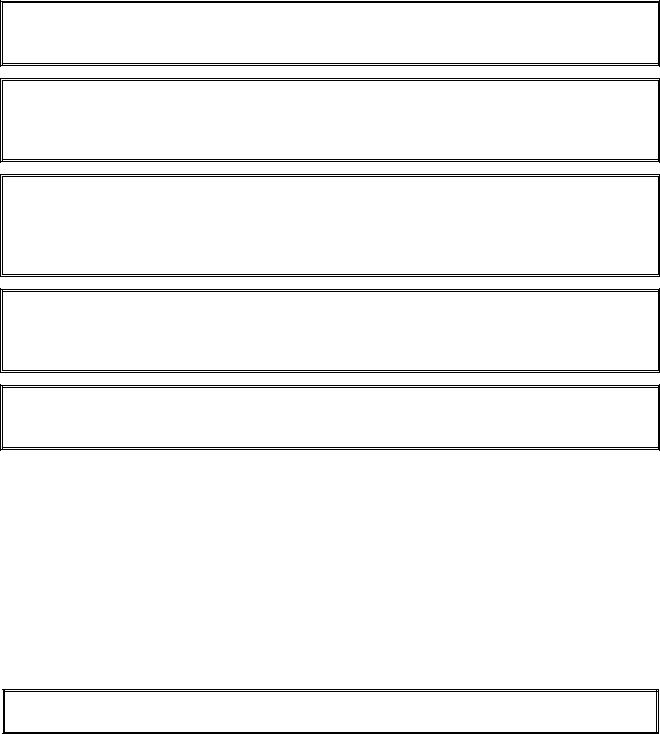
 DANGER
DANGER
This appliance must be connected to a power supply having the same voltage and phase as specified on the rating plate located on the inside of the appliance door.
 DANGER
DANGER
All wiring connections for this appliance must be made in accordance with the wiring diagram(s) furnished with the appliance. Refer to the wiring diagram(s) affixed to the inside of the appliance door when installing or servicing this equipment.
 DANGER
DANGER
Frymaster appliances equipped with legs are for stationary installations. Appliances fitted with legs must be lifted during movement to avoid damage to the appliance and bodily injury. For movable installations, optional equipment casters must be used. Questions? Call 1-800-551-8633.
 DANGER
DANGER
Do not attach an apron drainboard to a fryer. The fryer may become unstable, tip over and cause injury. The appliance area must be kept free and clear of combustible material at all times.
 DANGER
DANGER
Building codes prohibit a fryer with its open tank of hot oil being installed beside an open flame of any type, including those of broilers and ranges.
In the event of a power failure, the fryer(s) will automatically shut down. If this occurs, turn the power switch OFF. Do not attempt to start the fryer(s) until power is restored.
2.1.1 Clearance and Ventilation
This appliance must be kept free and clear of combustible material, except that it may be installed on combustible floors.
A clearance of 6 inches (15cm) must be provided at both sides and back adjacent to combustible construction. A minimum of 24 inches (61cm) should be provided at the front of the equipment for servicing and proper operation.
 WARNING
WARNING
Do not block the area around the base or under the fryers.
2.1.2 Electrical Grounding Requirements
All electrically operated appliances must be grounded in accordance with all applicable national and local codes, and, where applicable, CE codes. All units (cord connected or permanently connected) should be connected to a grounded power supply system. A wiring diagram is located on the inside of the fryer door. Refer to the rating plate on the inside of the fryer door for proper voltages.
2-2
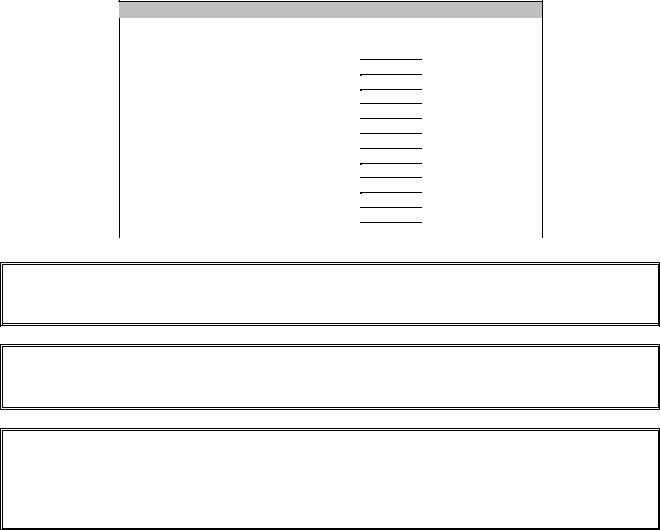
2.1.3 Australian Requirements
To be installed in accordance with AS 5601 / AG 601, local authority, gas, electricity, and any other relevant statutory regulations.
2.2Power Requirements
Three (3) Phase Requirements
|
|
WIRE |
MINIMUM WIRE |
AMPS |
||
MODEL |
VOLTAGE |
SIZE |
|
|||
SERVICE |
(mm) |
(per leg) |
||||
|
|
|
AWG |
|
||
FPEL14 |
208 |
3 |
6 |
|
(4.11) |
39 |
FPEL14 |
240 |
3 |
6 |
|
(4.11) |
34 |
FPEL14 |
480 |
3 |
8 |
|
(2.59) |
17 |
FPEL14 |
220/380 |
4 |
6 |
|
(4.11) |
21 |
FPEL14 |
240/415 |
4 |
6 |
|
(4.11) |
20 |
FPEL14 |
230/400 |
4 |
6 |
|
(4.11) |
21 |
|
||||||
FPEL17 |
208 |
3 |
6 |
|
(4.11) |
48 |
FPEL17 |
240 |
3 |
6 |
|
(4.11) |
41 |
FPEL17 |
480 |
3 |
6 |
|
(4.11) |
21 |
FPEL17 |
220/380 |
4 |
6 |
|
(4.11) |
26 |
FPEL17 |
240/415 |
4 |
6 |
|
(4.11) |
24 |
FPEL17 |
230/400 |
4 |
6 |
|
(4.11) |
25 |
|
||||||
NOTICE
If this appliance is permanently connected to fixed wiring, it must be connected by means of copper wires having a temperature rating of not less than 167°F (75°C).
 DANGER
DANGER
This appliance must be connected to a power supply having the same voltage and phase as specified on the rating plate located on the inside of the appliance door.
 DANGER
DANGER
All wiring connections for this appliance must be made in accordance with the wiring diagram(s) furnished with the appliance. Refer to the wiring diagram(s) affixed to the inside of the appliance door when installing or servicing this equipment.
2-3
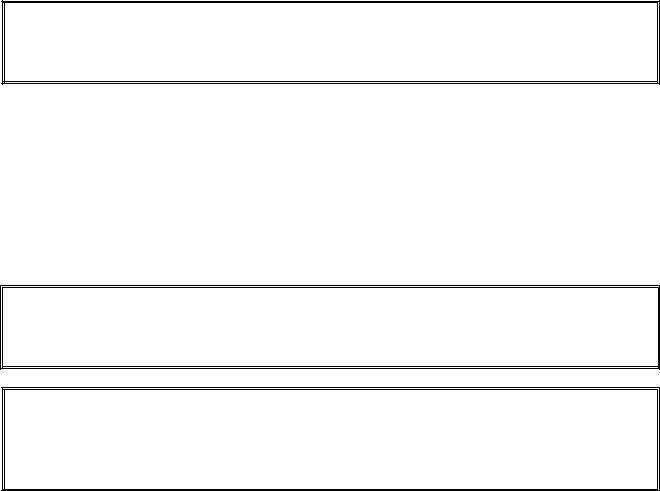
2.3Positioning the Fryer
 DANGER
DANGER
No structural material on the fryer should be altered or removed to accommodate placement of the fryer under a hood. Questions? Call the Frymaster Dean Service Hotline at 1-800-551-8633.
1.Once the fryer has been positioned at the frying station, use a carpenter’s level placed across the top of the frypot to verify that the unit is level, both side-to-side and front-to-back.
To level fryers, adjust the casters being careful to ensure the fryer(s) are at the proper height in the frying station.
When the fryer is leveled in its final position, install the restraints provided by the KES to limit its movement so that it does not depend on or transmit stress to the electrical conduit or connection. Install the restraints in accordance with the provided instructions. If the restraints are disconnected for service or other reasons, they must be reconnected before the fryer is used.
 DANGER
DANGER
Adequate means must be provided to limit the movement of this appliance without depending on or transmitting stress to the electrical conduit. A restraint kit is provided with the fryer. If the restraint kit is missing contact your local KES.
 DANGER
DANGER
Hot oil can cause severe burns. Avoid contact. Under all circumstances, oil must be removed from the fryer before attempting to move it to avoid oil spills, falls and severe burns. This fryer may tip and cause personal injury if not secured in a stationary position.
2.Close fryer drain-valve(s).
3.Clean and fill frypot(s) to the bottom oil level line with cooking oil. (See Equipment Setup and Shutdown Procedures in Chapter 3.)
2-4

OCF30™ SERIES ELECTRIC FRYER
CHAPTER 3: OPERATING INSTRUCTIONS
FINDING YOUR WAY AROUND THE OCF30™ SERIES ELECTRIC FRYER
Basket |
Lift Rod |
Elements |
Tilt |
|
|
||
Hanger |
|
|
Housing |
|
|
|
Top Cap |
Controller |
|
|
Bezel |
(3000 Shown) |
|
|
Power |
|
|
|
Switch |
|
|
|
(Domestic |
Fuse |
|
|
Only) |
 Drain
Drain
Handle
Filter
Handle
Filter Pan FootPrint Pro Built- |
|
JIB reset |
Optional JIB |
button |
|
In Filtration Unit |
(See Sec. 3.3) |
|
TYPICAL CONFIGURATION (FPEL214 SHOWN)
NOTE: The appearance of your fryer may differ slightly from that shown depending upon the configuration and date of manufacture.
3–1
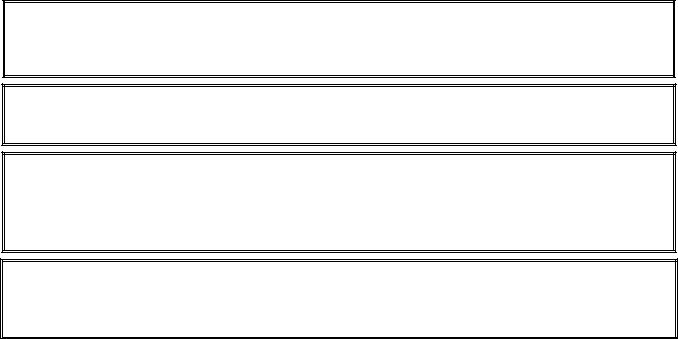
3.1 Equipment Setup and Shutdown Procedures
Setup
 DANGER
DANGER
Never operate the appliance with an empty frypot. The frypot must be filled to the fill line with water or oil before energizing the elements. Failure to do so will result in irreparable damage to the elements and may cause a fire.
 DANGER
DANGER
Remove all drops of water from the frypot before filling with oil. Failure to do so will cause spattering of hot liquid when the oil is heated to cooking temperature.
 WARNING
WARNING
The OCF30™ with the automatic top off is NOT intended to use solid shortening. Use only liquid shortening with this fryer. The use of solid shortening will clog the oil lines. The cooking oil capacity of the OCF30™ Series electric fryer is 31 lbs. (3.7 gallons/14 liters) at 70°F (21°C).
 DANGER
DANGER
When using solid shortening, pack the shortening down into the bottom of the frypot. DO NOT operate the fryer with a solid block of shortening sitting in the upper portion of the frypot. This will cause damage to the frypot and may cause a flash fire.
Prior to filling frypots with oil ensure all drains are closed.
1.Fill the frypot with cooking oil to the bottom OIL LEVEL line located on the rear of the frypot. This will allow for oil expansion as heat is applied. Do not fill cold oil any higher than the bottom line; overflow may occur as heat expands the oil.
2.Ensure that the power cord(s) is/are plugged into the appropriate receptacle(s). Verify that the face of the plug is flush with the outlet plate, with no portion of the prongs visible.
3.Ensure that the power is switched on. Some models are equipped with a master switch located behind the fryer door cabinet on the front panel of the component box, next to the fuse. OFF is displayed on the controller.
4.Ensure that the controller is switched ON. When the controller is switched on, the fryer will begin heating and will display MLT-CYCL alternating with the temperature and setpoint until the fryer temperature reaches 180°F (82°C). On CM 3.5 equipped fryers the display changes to LOW TEMP until within 15°F of the setpoint. Then the display changes to product or dashed lines. On the 3000, once the fryer reaches setpoint, the controller display changes to DROP and the fryer is ready for use. To exit the melt cycle on the 3000, press the EXIT COOL button. Answer YES to EXIT MELT?
5.Ensure that the oil level is at the top OIL LEVEL line when the oil is at its cooking temperature.
Shutdown
1.Filter the oil and clean the fryers (See Chapters 5 and 6). If using a CM3.5 reverse steps 1 and 2.
2.Turn the fryer off.
3.Place the frypot covers on the frypots.
3.2 Operation
This fryer is equipped with either 3000 or CM3.5 controllers (illustrated on the following page). Fryers with 3000 controllers should refer to the 3000 Controller Manual 819-6872 for the controller programming and operating procedure. For CM3.5 controllers refer to the separate Frymaster Fryer Controllers User’s Manual furnished with your fryer for the specific controller operating instructions.
3–2
